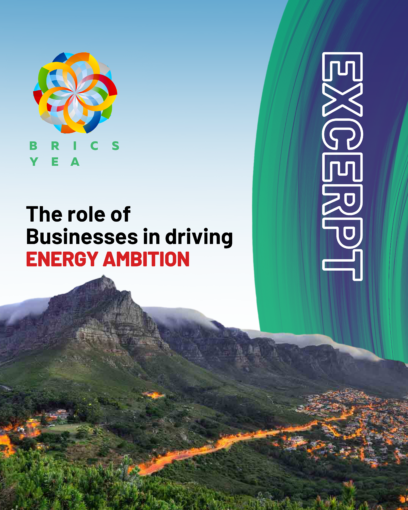
03 June 2023
The Role of Businesses in Driving Energy Ambition
The 2015 Agreement in Paris laid the edifice for the concepts of climate adaptation and mitigation. Member countries agreed on keeping the increase in global warming well below 2°C with a promise to reduce carbon emissions. Targets were set in order to reach the net-zero target by the end of the 21st century.
According to the 2021 report by the Intergovernmental Panel on Climate Change, this is only possible if we can cut pollution levels by at least half the amount being produced today by 2030.
While the national sovereign governments can take suitable steps towards achieving the set goal, it cannot be done without the contribution of other stakeholders. A major proportion of these emissions, come from personal vehicles, household activities, commercial establishments, and agriculture. Through policy measures in each of these areas, countries should aim to clamp down on pollution for a sustainable future.
It has been observed that businesses that are able to reduce emissions in their operations and supply chains to provide a pathway towards just transition, will cater better to investor and consumer expectations. According to a 2018 survey, 79% of executives from SBT-committed companies observed an increase in brand reputation; 52% found a boost in their investor confidence; 63% noticed an acceleration in innovation; and 55% have gained an edge in the competitive marketplace.
The UN Environment’s Emissions Gap Report acknowledged the fact that voluntary climate action by non-state actors can help bridge the gap between the commitments presented via policies that are undertaken, and those taken up on multilateral levels. According to the aforementioned report, “more than 2000 businesses and more than 500 cities have already signed up for the Race to Zero campaign ahead of COP26.”
To bring about the proposed changes, there needs to be an overhaul of how business is conducted every day. Sustainable and climate-friendly means ought to be adopted with the help of policymakers. Effective interaction between the state and industrialists is a prerequisite for successfully bridging the target gap. This would encourage climate action on a wider scale, which would drive climate ambition virtuously.
For a start, minimizing paper waste can contribute towards a sustainable business model. Paper recycling can decrease the latent cost of managing paper which is much higher than the buying cost. Recycling not only for paperwork but in glassware and food waste is also an idea that should be implemented. Taking this a step further, energy conservation should be in focus next. Assessment of daily heating requirements should be used to set a central thermostat to a specific temperature. Digital activity and workplace conveyance are two areas that can be worked upon. Gaskell stated in an article, “While consuming digital resources, such as video conferencing, burns a considerable amount of energy in data centres, the researchers argue that the net impact is still positive, with Zoom calls emitting just 0.6% of the carbon emissions generated on a typical commute.” Similarly, One study found that working remotely for four days of the work week could reduce nitrogen dioxide emissions from traffic by 10%. This needs to be addressed by national and subnational entities together to create a sustainable environment.
As far as value addition and supply chain are concerned, businesses need to ensure a solid foundation for “green values”. The output will be environmentally safe only if it is ensured at each step of the production process. Environmental Management Systems to track and develop a report on resource consumption are also suggested solutions. But implementation of such a system will be more effective when there is a system of checks and balances. The state and non-state entities can hold each other responsible for this collective goal of a better environment. There are several other guidelines and aiding mechanisms, for example, the OECD guidelines, waiting to be utilized.
It has been observed that businesses working towards climate adaptation and mitigation are experiencing business benefits like growth, innovation, and quality jobs. In a 2018 survey, 79% of executives from science-based target-committed companies have seen an increase in brand reputation; 52% have found that their SBT has boosted investor confidence; 63% say innovation has accelerated; and 55% have gained an edge in the free market economies. Recent results also show that RE100 companies are financially more profitable than their competitors, with net profit margins up to 7.7% higher than their peers.
Businesses themselves have been volunteering for adopting sustainable means. Business coalitions and conferences are now giving importance to climate-related agendas. The discussions provide a meaningful beginning to climate goals. The India Global Forum and the We Mean Business coalition are respective examples of the same. The latter had provided some recommendations at the Talanoa Dialogue such as zero-carbon fleets, zero-carbon buildings, zero-carbon grids, 100% climate-smart agriculture etc. that would have initiated a system-wide change to achieve the Paris Agreement goals. Many companies have now set renewable energy and energy efficiency targets, including Indian businesses that are also increasingly putting an internal price on carbon to meet their climate ambitions, 25 of which are already pricing carbon and 33 more are planning to adopt the practice by next year, according to CDP.
The need of the hour is a timely push by state entities for businesses to implement measures that would help make the net-zero target manifestation a reality. Multilateral groupings like the BRICS can play a crucial role in incentivizing business-led reforms. The discussions promoted by groupings such as these promote direct dialogue among businesses and policymakers. Multilateral cooperation on global risks is the right way forward, and it should be pursued with fervor. International coverage of clean energy and climate mitigation can act as an engine to drive climate ambitions further.
Author: Anusha Shrivastav, The Geostrata
Share news


